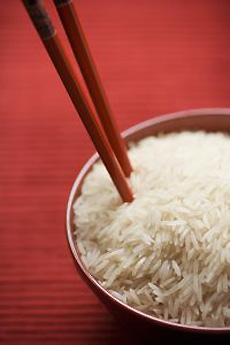

Basmati rice, a long-grain cultivar from India known for its fragrance and subtle flavor, has been discovered in recent years by American chefs. Photo by Brandon W. Mosley | SXC.
October 2007
Updated June 2025
|
 |
Rice: History & Types Of Rice
Learn About The Numerous Rice Types In Our Rice Glossary
Page 1a: Introduction
CAPSULE REPORT: There are literally thousands, perhaps as many as 40,000 or more, varieties of rice grown on every continent except Antarctica. Learn all about rice, how it is cultivated, and the many different types of rice in this comprehensive review. Click on the black links below to visit other pages of the article.
Introduction
Rice, with origins in both Asia and Africa, is the most widely consumed grain in the world. It feeds a third of the world’s population: 590 million tons of rice were produced in 2003. The Chinese word for rice is the same as the word for food (as well as agriculture and culture). In Japan, the word for cooked rice is the same word for a meal. In Thailand, when you call your family to a meal, you say, “Eat rice.” Since it was first harvested growing wild, through today, rice means prosperity—the end to hunger.
Rice is nutritious. Rice is high in complex carbohydrates, contains almost no fat, is cholesterol-free, and is low in sodium, except for the salt added to the cooking water. All rice, both brown and white, is considered a good source of vitamins and minerals. Although almost all the nutrients are stripped from white rice when the bran layer is removed during milling, 90% of all American-grown rice is enriched with thiamine, niacin, and iron, and in some instances, riboflavin, Vitamin D, and calcium. White rice, because it is enriched, has more iron and thiamine than brown rice. Brown rice has five times more Vitamin E and three times more magnesium.
Brown rice provides twice as much fiber as white rice, but it is not an especially rich source of fiber. On the other hand, rice bran alone is an excellent source of fiber. Rice is a fair source of protein, containing all eight essential amino acids. It is low in the amino acid lysine, which is found in beans, making the classic combination of rice and beans, popularly known as complementary proteins, a particularly healthful dish. Rice is gluten-free and easily digestible, making it a good choice for infants and people with wheat allergies or digestive problems. While exact counts will vary based on the type of rice, a half cup of cooked white rice provides 82 calories; an equal amount of brown rice provides 89 calories; 0 grams fat, 0 grams saturated fat, 0 grams trans fat, 0 milligrams sodium, 45 grams total carbohydrate (15% Daily Value), 0 grams sugar and 3 grams of protein.
Rice consumption is on the rise. In fact, Americans eat twice as much rice now as they did 10 years ago. Eating healthier foods is certainly a significant part of the picture, but the growth of interest in, and access to, the rice-based cuisines of India, Japan, Thailand, and Vietnam, and the beautiful “gourmet” rice available to chefs and consumers, have also contributed to the growth.
Continue To Page 1b: The History Of Rice
Go To The Article Index Above

|




